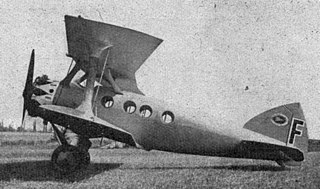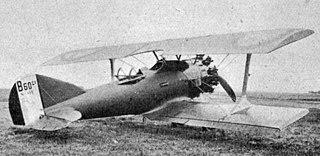
The Bloch MB.162 was a French four-engine, long-range bomber developed by Société des Avions Marcel Bloch in the late 1930s. Only a single prototype was built; after capture by German forces, it was pressed into service with the Luftwaffe as a transport.

The Blériot-SPAD S.34 was a French twin-seat, single-engine biplane flight training aircraft designed in 1920. The side-by-side seating arrangement was unique for its time. 150 aircraft were built, 125 for the French Air Force, who used them until 1936.

Potez 25 was a French twin-seat, single-engine sesquiplane designed during the 1920s. A multi-purpose fighter-bomber, it was designed as a line aircraft and used in a variety of roles, including fighter and escort missions, tactical bombing and reconnaissance missions. In the late 1920s and early 1930s, Potez 25 was the standard multi-purpose aircraft of over 20 air forces, including French and Polish. It was also popular among private operators, notably mail transport companies.

The Blériot 165 was a French airliner of the 1920s. It was a twin-engined biplane, a final development in the family of designs that began with the Blériot 115. Two were built for Air Union to replace the Farman Goliath on their Paris–London route and were christened Leonardo da Vinci and Octave Chanute. The airline found that it preferred the Lioré et Olivier LeO 21s that it had ordered alongside this aircraft, meaning that no further examples were produced.

The Blériot-SPAD S.56 was a family of French airliners developed in the 1920s as various refinements of the S.33 design. All S.56 versions shared two new features: the first was a newly designed, all-metal wing, replacing the wooden wing of earlier related designs and the second was a redesigned passenger cabin, replacing the S.33's four single seats in a row with two rows of double seats. A second access door was also added.

The Blériot-SPAD S.61 was a French fighter aircraft developed in 1923. Designed by André Herbemont, the S.61 was a conventional biplane, abandoning the swept upper wing used by Herbemont in several previous designs. The prototype S.61 was evaluated by the French Air Force alongside the S.51 as a potential new fighter, but like its stablemate, was rejected. The Polish Air Force was impressed enough to order 250, as well as purchase licences for local production. The Romanian Air Force also ordered 100 aircraft. About 30 were built in Poland, by the CWL.
The Blériot-SPAD S.81 was a French fighter aircraft developed in 1923 to a requirement by the French Air Force. It was flown competitively against the Dewoitine D.1 and was selected over that aircraft due to the Dewoitine's more radical design, leading to an order for 80 aircraft. The S.81 was a single-bay biplane of conventional configuration with I-shaped interplane struts and lacking Herbemont's usual swept upper wing. It featured a wooden fuselage of monocoque construction and metal wings skinned in fabric. Production versions differed from the prototypes in having a lengthened fuselage and larger tail fin.

The CAMS 55 was a reconnaissance flying boat built in France in the late 1920s which equipped the French Navy throughout the 1930s.

The Potez 62 was a French twin-engine civil airliner, designed by Henry Potez in 1934. The French military adapted this airframe two-years later to create the Potez 650.

The Gourdou-Leseurre GL-812 HY was a 3-seat reconnaissance floatplane, built by Gourdou-Leseurre.

The Morane-Saulnier MS.230 aircraft was the main elementary trainer for the French Armée de l'Air throughout the 1930s. Almost all French pilots flying for the Armée de l'Air at the outbreak of World War II had had their earliest flight training in this machine. It was the equivalent of the Stearman trainer in the United States air services and the de Havilland Tiger Moth in the British Royal Air Force.

The Farman F.190 was a utility aircraft built in France in the 1920s and 1930s. It was a high-wing, strut-braced monoplane of conventional configuration with a fully enclosed cabin and fixed, tailskid undercarriage. Popular both as a private aircraft and in the air taxi role, some 30 examples were also operated by airlines in France and elsewhere in Europe. Fifteen of these joined Air France's fleet in 1933 from the fleets of the smaller airlines it had absorbed.

The Morane-Saulnier Vanneau is a two-seat basic trainer built in France by Morane-Saulnier and ordered by the French Air Force.

The Lioré et Olivier H-190 was a biplane flying boat aircraft designed and produced by the French aircraft manufacturer Lioré et Olivier.

The Farman NC.470 was a French twin-engined floatplane designed as a crew trainer for the French Navy. It was used in small numbers for both its intended role as a trainer and as a coastal reconnaissance aircraft at the start of World War II.

The Blériot-SPAD S.91 was a French light-weight fighter aircraft. It would be later developed into the Blériot-SPAD S.510, the last biplane produced by the French aeronautic industries.
The SPAD S.XV was a single-seat fighter designed and built in France and offered to fulfil a 1918 C1 specification.
The Bréguet 610 was a reconnaissance seaplane built in 1934 by the Bréguet company.
The Lioré et Olivier LeO H-22 was a French amphibious plane, primarily intended for aerial mail transport.

The Blériot-SPAD S.60 was a French fighter aircraft developed in the late 1920s.


















